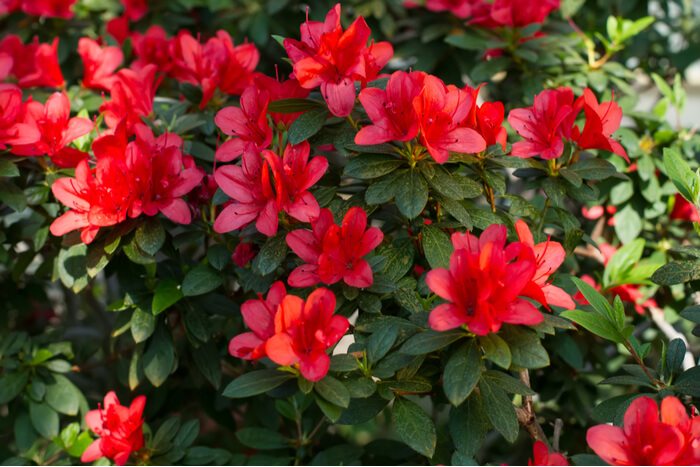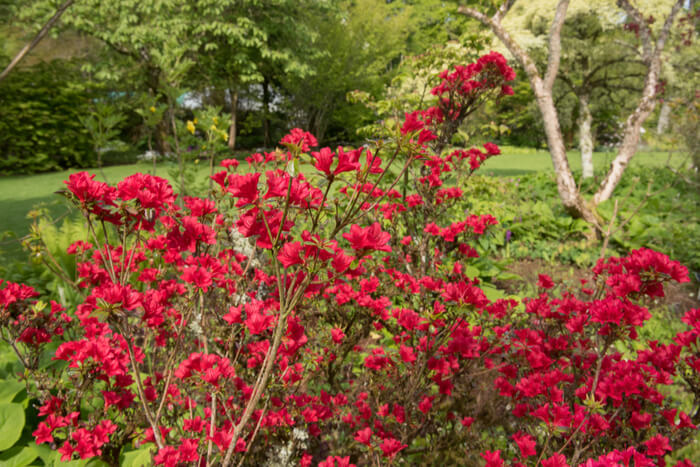Azaleas are available in a wide array of colors. There are the pink ones, the red varieties, and the plain white ones. Whichever way you go, you are sure to brighten up your yard. You can have them growing in and around wooden sheds for that added aesthetic appeal. The good thing about them is that they are easy to grow and maintain. And as long as you keep up with aftercare practices, they will bloom each year.

If you wish to have a lovely yard even in the winter months, go for the evergreen types. Is your interest piqued yet? If yes, continue reading for steps on how to handle these lovely plants:
Variety Selection
It always helps to have a selection. In this way, you can choose what best works for your yard. With these plants, you have a lot from which you can choose. It is important to note that they do well in regions with mild winter conditions and long hot months. The good thing about them is that they are hardy. Thus, whether you are planting them in or outside wooden sheds, they are bound to thrive.
Also, do note that the various types will call for different requirements. Visiting your local nursery or conducting some research will help you make the best decision for your yard. In this case, we will focus on the primary classes, which are the native and Asian types.
The native plants will grow a lot like vines. You will find that they do not need much pruning, which cuts down on maintenance work. There are some varieties which lose their leaves in the winter. These are great for people living in warm regions.

The Asian types are evergreen, and they grow as shrubs. In this category, there are two options. There are the Kurume Hybrids which feature a bright red hue. These are best in one location, and you can thus have them in containers or raised beds. You can also opt to plant them directly in the ground. They do not call for much maintenance work and can reach heights of four feet. The other option is the Southern Indian Hybrids. These are quite large as compared to the former. They have an array of color options and are great for large spaces. You should note that they will require pruning now and then. Thus, you have a bit of maintenance work cut out for you.
You do not have to settle for one variety as it is possible to mix two or even more. The thing that matters most is the suitability of the chosen type with your climate.
Planting Site Selection
Shade
What should you consider when choosing a planting spot? Well, though these plants are somewhat tolerant to heat, you need to find some cover for them. You must find a balance between sun exposure and shade. Where they have constant access to daylight, they will not thrive. However, it depends on the variety. Some do well under the shade while the deciduous ones will be okay under full exposure. It is always best to look into the requirements of your chosen type.

Drainage
Well-draining soil is of the essence if you wish to see the azaleas grow well. If the soil retains water after rains, it will encourage the rotting of roots. An easy way to check for the drainage is to dig a hole and fill it with water. Where there is standing water after a day, this spot has poor drainage. The same goes for if the water drains very fast. The good thing about drainage is that you can amend it with the use of organic matter. You should dig to several feet, break up the soil, and incorporate the organic matter. If this feels like a lot of work, you can opt to have a raised bed. People planting in wooden sheds can have the plants in pots where they can easily regulate the flow of water.
pH
The acidity or lack thereof of the soil will affect the growth of your plants. Something from 5.5 to 6 is acceptable as these plants do best in slightly acidic soil. Where the soil is alkaline, add some sulfur as you see fit. Also on this note, avoid having the plants in areas which can leach out lime. Examples of this include foundations and sidewalks.
Planting
With the above preparations underway, you can now plant the azaleas. You will need a garden shovel for this, which you will use to dig a hole. The pit should be large enough to accommodate the roots as well as the bottom of the plants. Proceed to remove the azaleas from the containers and loosen the root balls to prepare them for growth. Moisten them by dipping the root balls in water or hosing them down as this will encourage their growth. Set the plant in the middle of the hole, ensuring that the root ball lies above the ground level to some extent. Then surround the plant with soil and once you fill the pit, pat around the root ball with your fingertips. If you plan on having more than one plant in the garden, be sure to space them apart by several feet. Else, they will compete for nutrients and will thus not thrive.

Watering should be thorough and slow, taking place as from the next day. This practice should continue until the roots take hold, ensuring that the plants get watered at least once a week. You can check for the need for watering by dipping your finger into the soil. Too much water will kill the plants, and the same goes for minimal watering. Aim to have a damp environment, rather than a dry or wet one, and your plants will do fine.
Mulching can help you with reducing evaporation as well as preventing the growth of weeds. Additionally, the decomposed matter adds to the nutrients in the soil and regulates the temperature. Fertilization of the plants is okay, though not necessary; only proceed with it where you deem it appropriate. Otherwise, you can do away with it in entirety.
Pruning will depend on the plant type, so be sure to consider this in your aftercare practices. That’s all there is to know regarding growing and caring for azaleas. Good luck!




